
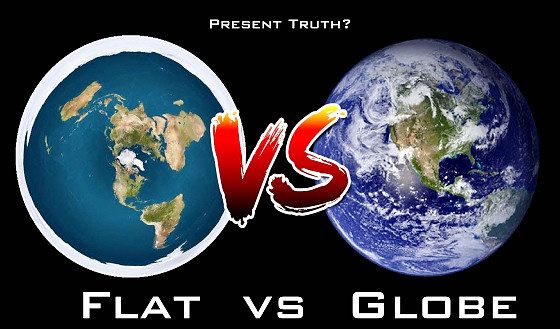
A Reply to Danavir Goswami's Article, "Flat-Earth or Globe?"
BY: MAYESVARA DASA
Jun 14, 2019 — IRELAND (SUN) — Part Two
The following is the continuation of a reply to Danavir Goswami's article "Flat-Earth or Globe". The first part of this paper can be found here.
In part one of this we paper we cited a history from the Garga Samhita wherein Sri-Krishna states that there is only one Earth in the universe: sri bhagavan uvaca anya na medini loke. (Garga-Samhita, Canto six, chapter 9). The Vedic Earth is described in chapters 16-26 of the fifth canto of Srimad Bhagavatam. The same description is repeated (with more or less details) in the cosmological sections of all the major and minor Puranas (Vedic histories). Drawing from these sources we have established in our first paper that the size of the Vedic Earth is measured at panchsat-koti-yojana or four billion miles.
In this Part Two we shall establish that the shape of the Vedic Earth is a circular plane (a flat-Earth). By flat-Earth we mean a landscape that continues along a horizontal plane as opposed to the idea of a landscape that curves around a globe. On the basis of this description of the overall shape and size of the Vedic Earth-circle, in part three of this paper we shall argue that the Puranas measurements for our local area of the Earth-circle (located in Bharata-varsha), should be understood as referring to a very small part of a much greater flat-Earth plane, and not to an isolated globe that floats in space.
As mentioned in part one of this paper, the amount of energy, focus, and argumentation expended by those hoping to prove that the Vedic Earth is a globe, is completely out of proportion to the focus, energy, and argumentation that should be made in helping others understand the awesome revelation of the Earth's true magnitude, size, and nature as described in Srimad Bhagavatam. Its almost as if devotees writing on the subject have not heard the message. Members of ISKCON have certainly heard Srimad Bhagavatam, but Sukadeva Goswami's description of the Earth has obviously not yet registered. For example, if Dorothy hears that her husband Edward has just died, the shock may be such that the words don't register. Pretending as if nothing is amiss, Dorothy may continue in the distraction of house-work, speak something trivial, and smile reassuringly at the harbinger of doom, desperately hoping that the illusion of her world has not actually been shattered and destroyed by the dreadful news. Dorothy's pretence can only go so long before she has to look at the corpse, face the truth, and accept that life will never be the same again. In a similar way, the revelation of the Vedic Earth-circle is death for the globe, but the shock of the illusion being shattered may be such that devotees just go on busy as usual, falsely believing that the world they live in can be something other than that described in Srimad Bhagavatam.
As the Temple of Vedic Planetarium rises, Sri-Krishna will gradually awaken His devotees to the realization that the Earth we live on is a part of a colossal circular disc, and not a globe in space. The unveiling of Bhu-mandala is occurring at this time due to the effects of Sri Krishna Chaitanya Mahaprabhu's universal sankirtan movement which will broaden the horizon and reveal the whereabouts of the rest of the universal family. As the details of Bhu-mandala become wide-spread, the baseless arguments presented by those arguing on behalf of the globe paradigm will be countered one by one.
"The great globe itself. Yea, all which it inherit shall dissolve". (William Shakespeare, The Tempest, Act 4, scene 1)
DETERMINING THE SHAPE OF THE EARTH
As we have pointed out in many previous papers on Sampradaya Sun, and as we shall continue to point out, the so-called evidence from the Vedas that the Earth is a globe floating in space is completely fallacious. We have mentioned in part 1 of this paper that when the risihs think of 'the Earth', they think of Bhu-mandala. The rishis would not make the mistake of associating the entire Bhu-mandala with a supposed Earth globe of 24,900 mile circumference. But that is precisely the distortion of facts that Danavir Goswami has made in his association of the names of the Earth (Bhu-mandala) with the supposed Earth globe (see below). We shall explain later why Srila Prabhupada himself associated the Bhu-mandala with the Earth-globe idea. There is no fault on Srila Prabhupada's part since he was translating, writing, and speaking about the Earth before any real research into the subject of the Vedic Earth had begun. The same cannot be said of Danavir Goswami and others who have had many decades to understand the difference between the Vedic and modern conception of the Earth.
Danavir Goswami's erroneous identification of Bhu-mandala with the supposed Earth-globe is explicitly stated in his shocking misappropriation of the names of Bhu-mandala to further the idea that these names refer to 'the Earth globe':
Danvir Goswami: "We may note that there is agreement between the Puranic literature and Siddhantic literature on the specific nine islands created by Sagara's sons. Furthermore, there is concurrence on the spherical nature of earth which is coincidentally supported by the western scientific view also. The Bhagavata Purana refers to the earth as a globe in the following verses: 3.21.36 (mahīm), 4.9.51 (maṇḍalam), 4.18.29 (bhū-maṇḍalam); 4.21.36 (kṣoṇi-tale); 4.21.48 (pṛthvyāḥ), 4.24.10 (vasudhā-talam) 5.7.1 (avani-tala); 6.11.8 (gām), 7.3.5 (bhūḥ); 8.7.26 (kṣitim), 8.19.5 (mahīm), 10.68.46 (bhū-maṇḍalaṁ), 12.2.7 (kṣiti-maṇḍale)."
Actually, despite what Danavir Goswami says here, the Bhagavata Purana itself never refers to the Earth as a globe. Yes, in all of the above verses Srila Prabhupada has certainly translated these various names of the Bhu-mandala using the conventional term 'Earth globe', but Sukadeva Goswami's description of the said Earth in chapters 16-26 of the fifth canto of Srimad Bhagavatam in no way corresponds to the modern Earth-globe conception. Why does Danavir Goswami not point out the difference? In previous papers we have already gone through many of the above verses and purports before and explained them in context of the description of the Earth given in the fifth canto. Lack of space prevents me from repeating the details here, but one should know that any time the Earth is mentioned in Srimad Bhagavatam, Mahabharata, Ramayana, or any other Vedic scripture, the Earth in question is that described by Sukadeva Goswami in chapters 16-26 of the fifth canto. The same description of Earth is repeated in the cosmological section of every other Purana (usually with either more or less details). Anyone can read the description of Bhu-mandala and see that there is zero comparison between Bhu-mandala and the so-called Earth globe. Danavir Goswami more than anyone is aware of this fact. Let us keep in mind that Danavir Goswami is presenting these names of Bhu-mandala as 'evidence' that the Earth is a globe, when in fact the names refer to an entirely different conception of the Earth. The error cannot be mere ignorance on Danavir Goswami's part as he has been researching and writing on Vedic cosmology for many years and is well aware that the description of Bhu-mandala's fantastic landscape in no way corresponds to the description of the Earth globe.
Danavir Goswami's presentation through-out his article is not even consistent. First he says that Bharata-khanda is the Earth globe, quote: "Regarding the earth we live on which is called Bharata-khaṇḍa, it appears that it is a completely round sphere" . Then he says above that the names of Bhu-mandala (of which Bharata-khanda is just a small part) are also references to the so-called Earth globe, quote: "The Bhagavata Purana refers to the earth as a globe in the following verses: 3.21.36 (mahim), 4.9.51 (mandalam), 4.18.29 (bhu-mandalam)" . As we all should know, Bharata-varsha is a part of Bhu-mandala, not Bhu-mandala itself, and thus there can be no grounds to equate the names of one with the other. This is not just just a question of my opinion against Danavir Goswami, it is a question of everyone clearly understanding that a person cannot falsely conflate names in order to win an argument. If this was an examination Danavir Goswami's answer would be marked wrong, for it is simply wrong to say that the name Bharata-khanda and the name Bhu-mandala are references to the same Earth-globe. Danavir Goswami resides in Kansas. Kansas is part of America. Danavir Goswami cannot argue that Kansas is America. In the same way, Bharata-kanda is described in the Puranas as a part of Bhu-mandala. Danavir Goswami cannot simultaneously say that Bharata-kanda is Bhu-mandala. Since Danavir Goswami wishes to argue that the names Bharata-khanda and Bhu-mandala are names for the same Earth globe, he has clearly fallen into a categorical mistake. Sukadeva Goswami mentioned to Pariksit Maharaja that he would explain nama-rupa (the names and form of the Earth). The name Paul indicates a different person from the name John. If a person cannot tell that Paul is different from John then we may face a problem. Likewise, if members of ISKCON cannot tell the difference between Bharata-khanda and Bhu-mandala, they face the consequence of being bewildered by someone else constructing conceptions of the Vedic Earth which don't actually exist.
The above presentation by Danavir Goswami only goes to show the completely unfounded and misleading nature of the so-called 'evidence' for the Earth globe. Although Danavir Goswami is well aware that Bhu-mandala is 4 billion miles in diameter and that Bharata-varsha is just a part of Bhu-mandala, in order to make an argument for the globe, he does not distinguish the name or measurements of Bharata-varsha from the greater Bhu-mandala to which it belongs, but has simply conflated both concepts into a singular Earth globe idea. Danavir Goswami has thus bewildered people into falsely associating the name of Bhu-mandala with the globular shape of the so-called Earth planet. He has failed to correctly inform his inquirer that the various names of Bhu-mandala are references to a circular disc with a diameter of 4 billion miles diameter.
Frankly we are dumbfounded at Danavir Goswami's blatant misuse of the names of Bhumi. First of all the choice of names by Danavir Goswami does not even support his argument since these names don't even refer to the shape of the Earth. As stated in the Devi Purana:
"This Earth is termed Dhara because it supports all; is termed Prithvi because it is very capacious [vast, huge, immense, etc]; and it is called Mahi because it is great, since it supports so many beings. O King, the Ananta serpent is holding it on her thousand-hoods. " (Devi Purana, Book 3, chapter 12, verses 8-9)
Several of these names (Mahi, Prithvi, etc.) are simply in reference to the Earth's colossal size at fifty crore yojana (4 billion miles) which makes Her the support of so many living beings. If Danavir Goswami wishes to argue that the names Bhu-mandala, etc., refer to the Earth globe, then how does he account for the fact that the Puranas measure Bhu-mandala at fifty crore yojana (4 billion miles). Such a huge size is completely incongruent with the measurement of the supposed Earth globe at 24,900 miles. How can Danvir Goswami think that something which is measured at 4 billion miles is the same thing as something measured at 24,900 miles? This is ridiculous. If the name Bhu-mandala is a reference to the Earth globe, then our so-called Earth globe would be 4 billion miles in diameter, and there would be no room for anything else in the globe-shaped universe because the entire universe is only four billion miles. The Srimad Bhagavatam describes the universe itself as being globe-shaped; specifically it is described as being round like an egg: andakoso bahir ayam pancasat-koti-vistritah (SB 3.11.40). Here it compares the shape of the universe to the roundness of an egg (anda-kosah). Anda means egg—in this case a completely round egg since the entire universe is measured at four billion miles (pancasat-koti) from top to bottom and from side to side.
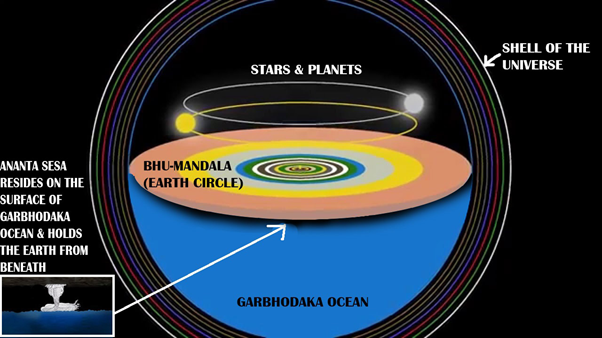
The lower part of the round-shaped universe is filled with the water of Garbhodaka ocean to a depth of 2 billion miles. Srila Prabhupada writes
"Now, in each brahmanda... This universe, what we are seeing, it is only half. Half is full with water. And where is that water, we cannot see. But there is water. Just like a ball, and half the ball, inside, is filled with water." (Lecture on Caitanya-caritamrta, Madhya-lila, 20.281-293, December, 18, 1966, New York)
Srila Prabhupada's comparison of the universe to a ball is apt because the anda or egg-shaped universe is completely round. As mentioned, the bottom half of the ball-shaped universe is filled with water, and this great body of water is called the Garbhodaka Ocean. Upon the surface of the Garbhodaka ocean is an incarnation of the Lord called Ananta-sesha who takes the form of a huge multi-headed serpent and holds the Bhu-mandala on one of His hoods. This great Earth circle or disc crosses the entire center of the universe, and is the home of innumerable civilizations and living beings. Anything above the surface of the Earth is regarded as the upper part of the universe which is a further 2 billion miles in height and contains the stars, planets, and other celestial lokas such as Mahar, Janas, Tapa, and Satyaloka. All of this is contained within the shell of the egg-shaped universe. Although the Earth has a diameter of 4 billion miles which is the width of the entire universe, the disc-shape of the Earth allows for space in the upper and lower parts of the universe. If the Earth itself was globe-shaped it would fill the entire universe leaving no room for anything else. Bhu-mandala is thus consistently described as circular disc with a diameter of 4 billion miles. This disc shaped landscape crosses the center of the universe and divides the universe into its upper and lower parts as shown in the image above. This creates the division of the modes of nature in the universe. The devas and others who are in the mode of sattva (goodness) reside in the upper part of the universe; the asuras and nagas who are in the mode of rajas (passion) and tamas (ignorance/darkness) reside in the lower part of the universe (in the underground realms of Bhu-mandala). Those completely overwhelmed by tamas (darkness) live in various hells which are also located deep within the Earth itself. Those who are in the mixed modes of goodness, passion, and ignorance reside on the surface of the Earth.
We can see here that the Srimad Bhagavatam clearly differentiates between the terms anda (egg-shape) and mandala (circle). If Sukadeva Goswami had wished to describe the Earth as round like an egg (anda), he would have done so. Instead he describes the Earth to be round like a circle (mandala). The great Earth circle (Bhu-mandala) depicted above is the one and only Earth described through-out the Puranas. In part one of this paper we cited the history of Anarta and his role in bringing Dvaraka to the Earth. In this narration, Sri-Krishna confirms there is only one Earth in His creation: sri bhagavan uvaca anya na medini loke, "the Supreme Personality of Godhead said, I do not have another Earth in this universe to give you". (Garga-Samhita, Canto six, chapter 9) .
Any of the other names of the Earth on the above list from Danavir Goswami such as Gam, Ksiti, Vasudha, etc., are all simply different names for 'the' Earth (Bhu-mandala) as it is described by Sukadeva Goswami in chapters 16-26 of the fifth canto of Srimad Bhagavatam. Any mention of the Earth in Srimad Bhagavatam is a reference to this description. Frankly, I'm rendered speechless at such a blatant misrepresentation of Srimad Bhagavatam. Danavir Goswami has been involved in translating books of Sanskrit, as well as writing on Vedic cosmology for decades now, and he more than anyone knows that the description of the colossal and fantastic landscapes of Bhu-mandala does not in any way conform to anything in our known so-called 'Earth-globe'. Danavir Goswami may argue that in this regard he is simply following Srila Prabhupada's translations and purports to Srimad Bhagavatam wherein Srila Prabhupada himself refers to Bhu-mandala as the Earth globe, but such a procedure ignores Srila Prabhupada's own disclaimer that he was not an expert in Vedic cosmology and astronomy, and that for the purpose of correctly presenting Vedic cosmology in the Temple of Vedic Planetarium, his disciples need to diligently 'understand the Sanskrit and English descriptions and present them'.
"We must exactly follow the description of Bhagavatam. As we are going to spend many crores of rupees, and there will be those who will try to find fault in our presentation, 'Caesar's wife must be above suspicion.' I have explained whatever I could already in my books. Now my brain is no longer able to work properly. You young men can tax your brains to understand the Sanskrit and English descriptions and present them. " (TKG's Diary: Prabhupada's Final Days, May 30 1977)
In the last section of today's paper we shall argue that the failure to properly 'understand the Sanskrit and English descriptions' of Bhu-mandala has led Danavir Goswami and others to falsely claim that Srila Prabhupada taught that the Earth is a globe (See below: 'Did Srila Prabhupada believe the Earth is a Globe?' ). Srila Prabhupada certainly spoke of the Earth in those terms during his preaching, but that is only because the actual description of the Vedic Earth had not yet been deciphered. The bottom line is that Srila Prabhupada ultimately believed the Earth must be as it is described in Srimad Bhagavatam. Srila Prabhupada referred to the revealing of the Vedic cosmos as part of an unfolding plan:
"That is our plan, to make a very big temple and to show all the planetary system within that from Srimad Bhagavatam…there are so many things to be known still from Vedic literature, it is not yet unfolded, but we are trying." (SB 7.9.8, Mayapur, February 15, 1976)
TERMS THAT DESCRIBE THE CIRCULAR NATURE OF THE EARTH
For those who cannot tell the description of an Earth-circle from an Earth-globe, lets go through this again...
In a book called Sri Mathura Mahatmya: The Glories of Mathura Mandala by Srila Rupa Goswami, the measurements for a circular area of the Earth are given. In that book Srila Rupa Goswami quotes from the Adi-Varaha Purana:
vimsati-yojananam tu mathuram mama mandalam...
"In the Adi-Varaha Purana it is said: My abode of Mathura mandala is 20 yojanain circumference. A person who stays there becomes free from all sins." (Srila Rupa Goswami, Sri Mathura Mahatmya, verse 3)
Here the Lord speaks of the holy land of Mathura being a circular area (mandalam) that has a circumference of 20 yojana (160 miles). Many if not most of the devotees within ISKCON will have traversed areas of this holy land including Sri Vrindavana dhama; and anyone who has went on pilgrimage to Mathura, can confidently assure those who have not been, that Mathura-mandala is not globe shaped, but is simply a flat area of land located in northern India. Pilgrims to Mathura follow the parikrama or circular route around the circumference of the mandala—they do not walk around a globe. No one would argue that the word mandala in this case is referring to a globe.
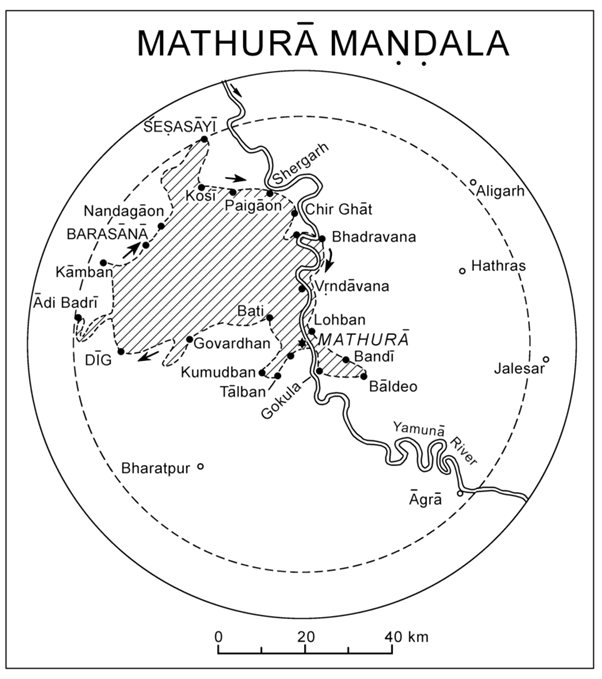
Map of Mathura-mandala in India
Regarding the use of the word 'mandala' in names like Bhu-mandala, Ksiti-mandala, Dhara-mandala, etc., a mandala as everyone familiar with mandalas knows, is a patterned circular formation, not a globe. Unless everyone is entitled to whimsically change the meaning of words, a green leafy vegetable will retain the name cabbage, and not banana; a seventy year old man will be called a senior and not a teenager; and likewise a mandala will known as a circle and not a globe.

In Srimad Bhagavatam it is said:
The festive rasa dance commenced, with the gopis arrayed in a circle (gopi-mandala—by the circle of gopis). (SB 10.33.3).
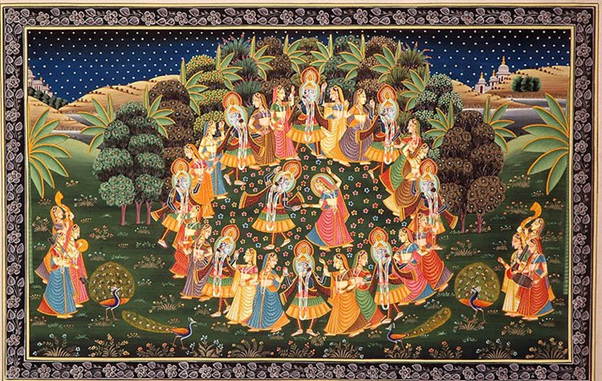
The gopis formed a circle (mandala) and danced with Krishna. The gopis did not become a globe.
The circular shape of the Earth is again confirmed by Sukadeva Goswami in the following verse:
sri-suka uvaca
etavan eva bhu-valayasya sannivesah pramana-lakshanato vyakhyatahSukadeva Gosvami said: My dear King, I have thus far described the diameter of the universe [fifty crores of yojanas, or four billion miles] and its general characteristics, according to the estimations of learned scholars. (SB 5.21.1)
Here Srila Prabhupada translates the words bhu-valayasya as 'the diameter of the universe.' However, Bhu is a specific name for the Earth itself and valaya means circle. Sukadeva Goswami is emphatically saying here that the Earth is a circle. Rings, armlets, bangles, or bracelets are also called valaya indicating their circular shape, indeed, the word valaya is used through-out Srimad Bhagavatam to describe bangles and bracelets; for example, in Kapila-deva's description of Lord Vishnu He says:
He also wears around His neck a garland of attractive sylvan flowers, and a swarm of bees, intoxicated by its delicious fragrance, hums about the garland. He is further superbly adorned with a pearl necklace, a crown and pairs of armlets, bracelets (valaya) and anklets. (SB 3.28.15)
A round enclosure or round military formation is also referred to as valaya. So Bhu-mandala or Bhu-valaya literally translates as "Earth-circle." A reference to a 4 billion mile diameter, bangle-shaped circle, is obviously not a reference to a globe-shaped ball.

A circular-shaped (valaya) Hare Krishna bracelet
In the above occasion, Srila Prabhupada has chosen to translate Bhu-valaya (Earth circle) as 'the diameter of the universe' because as mentioned the Vedic Earth is so huge that it spans the entire center of the universe, and is therefore of the same diameter as the universe itself. Srila Krishna dasa Kaviraja confirms this measurement of the universe in the Sri Caitanya-caritamrta:
krishna kahe, ei brahmanda pancasat koti yojana
"Krishna said, 'Your particular universe has a diameter of four billion miles'" (Caitanya-caritamrta, Madhya-lila, 21.84)
Again:
"The universe measures (brahmanda-pramana) five hundred million yojanas(pancasat-koti-yojana). Its length and breadth are one and the same." (Caitanya-caritamrta, Adi-lila, 5.97)
The measurement for the great round Earth of 4 billion miles in diameter (and which is held by Ananta-sesha) is also confirmed by Srila Krishna dasa Kaviraja in the Caitanya-caritamrta:
pancasat-koti-yojana prithivi-vistara
yanra eka-phane rahe sarshapa-akaraTRANSLATION
"The universe, which measures five hundred million yojanasin diameter, rests on one of His hoods like a mustard seed. (Adi-lila 5.119)
Although Srila Prabhupada translates the Sanskrit word for Earth (prithivi) as 'universe', the Sanskrit name prithivi is a specific name for the Earth. The verse unquestionably glorifies Ananta-Sesha who specifically holds the prithivi or Earth which is five hundred millions yojanasin diameter (pancasat-koti-yojana).
In his translations Srila Prabhupada would often conflate Sanskrit words for the Earth with words for the universe itself, so it is important to carefully check the context as Srila Prabhupada personally requested his followers to do, specifically in regards to understanding the specific details of the Vedic cosmos: "I have explained whatever I could already in my books. Now my brain is no longer able to work properly. You young men can tax your brains to understand the Sanskrit and English descriptions and present them." (TKG's Diary: Prabhupada's Final Days, May 30 1977). By following the description of the Earth given in chapters 16-26 of the fifth canto we can easily ascertain that the names Bhu-mandala or Bhu-valaya are describing the Earth as a circular and not a globe.
On different occasions, Srila Prabhupada presented the Sanskrit name Bhu-gola (round-Earth) as an indication that the Earth was round like a globe, but the actual Bhu-gola in question is measured at 4 billion miles in diameter. In SB 5.20.38 the measurement of Bhu-gola is given by Sukadeva Goswami as pancasat koti (4 billion miles):
pancasat-koti-ganitasya bhu-golasya (SB.5.20.38)
The Earth (bhu) is certainly round (gola), but is round like a bangle or bracelet, not like a ball. With a diameter of 50 crore yojana or 4 billion miles, the Bhu-mandala is certainly the largest feature in the Vedic universe and crosses the entire center of the universe (dividing it into upper and lower parts). As mentioned previously, the disc or circular shape of the Earth allows for space both below and above the Earth's surface. If the Bhu-gola/Bhu-mandala was a globe of 4 billion miles rather than a disc, there would be no space for any other planet or star in the universe as the complete universe is only 4 billion miles from top to bottom.
THE SHAPE OF JAMBUDVIPA DETERMINES THE SHAPE OF THE EARTH
So that all of us can be absolutely clear on the circular shape of the Earth, let us begin at the center of the circle. Sukadeva Goswami begins the description of the Earth by first describing the central and most important island (dvipa) known as Jambudvipa. He informs us that Jambudvipa is equally round like a lotus leaf:
samavartulo yatha pushkara-patram (SB 5.16.5)
samavartulah—equally round, or having a length and breadth of the same measurement; yatha—like; puskara-patram—a lotus leaf.

In the commentaries by the Vaishnava acharyas, Sri Vamsidhara states that "lotus leaf" here is not that which is related to the flower, but that which is used for eating (Commentary by Sri Vamsidhara to SB 5.16.5). The fact that it is a lotus leaf and equally round tells us that Jambudvipa is circular, not globular. Sukadeva Goswami's comparison of Jambudvipa to a lotus leaf indicates a flat-Earth landscape. A lotus leaf resting on water can be taken to be horizontal. Water in a pond, or indeed any body of water, is always at a level as any spirit level or plumb measure will indicate. Thus the salt-water ocean can to be taken to be level, and likewise, Jambudvipa Island which is compared to the round lotus leaf (resting on the water of a pond) can also be taken to be horizontal. In case it has escaped anyone's notice, we are indeed situated horizontally—not perpendicularly, upside down, curving around a bend or any other such manner in which people and things could possibly be found. The insanity created by the globe idea has resulted in otherwise rational and logical people believing that persons standing on opposite sides of a ball can both be in the same upright vertical position.
The comparison to a lotus leaf is apt because just as a lotus leaf is surrounded by water, so Jambudvipa is surrounded by a circular ocean as shown in the image below. Jambudvipa itself is 100,000 yojanaand the salt-water surrounding is also 100,000 yojana(800,000 miles).
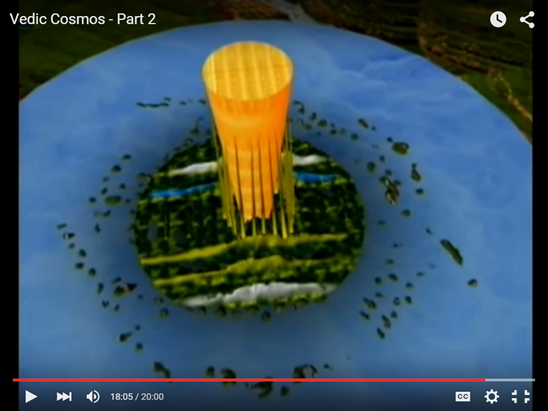
The circular formation of Jambudvipa is again confirmed in Brahma Purana which states that the salt-water ocean surrounds Jambudvipa like a bangle:
"O Brahmins, this Jambudvipa which consists of nine varshas and which extends to a hundred thousand yojanashas been mentioned by me. O Brahmins, the salt-water ocean that extends to a hundred thousand yojanas(800,000 miles) and is like a bangle in shape encircles the Jambudvipa externally" (Brahma Purana, 17.29)
Again, a bangle is circular in formation, not globular.

The comparison to the salt-water ocean encircling Jambudvipa like a bangle indicates that the landscape of Jambudvipa and its surrounding ocean is continuing along a horizontal plane, not curving around a globe. This can be understood with further references to the circular formation of Earth with its seven islands and oceans. In the Mahabharata, the encircling formation of the Earth's islands and oceans is compared to a belt. Through-out the Mahabharata, we hear the expression 'the Earth with her belt of seas'. This is not a reference to the oceans on a supposed Earth globe, but to the Earth's seven oceans cosmic-sized oceans that surround the seven cosmic-sized islands. The seven islands and oceans are described in chapters 16-20 of the fifth canto of the Srimad Bhagavatam. They cover an area of 202,800,000 miles. Below are a few examples describing 'the Earth with her belt of seas':
"Of unbaffled prowess, that chief of the Haihaya race of Kshatriyas swayed the whole Earth with her belt of seas, together with all her islands and all her precious mines of gold and gems". (Mahabharata, Book 13, Anasuya Parva, section CLII)
The following verse describes Lord Varaha lifting the Earth with her 'belt of seas:'
"I shall, assuming the form of boar and putting forth my strength, bring back the Earth with her belt of seas to her own position for the good of all creatures when she becomes submerged in water. I shall then slay the son of Diti". (Mahabharata, BOOK 12, Shanti parva, section CCCXL)
In a paper entitled, "Did Lord Varaha Lift an Earth Globe?", we have established that Varaha lifted the entire Bhu-mandala, and not a supposed Earth-globe, see here:
In the verse below it is said that Ananta-sesha holds 'the Earth with her belt of seas'. The following narration is part of the history of how Ananta-sesha came to hold the Bhu-mandala:
"Brahman said, 'O Sesha, I am exceedingly gratified with this thy self-denial and love of peace. But, at my command, let this act be done by thee for the good of my creatures. Bear thou, O Sesha, properly and well this Earth so unsteady with her mountains and forests, her seas and towns and retreats, so that she may be steady.'
"Sesha said, 'O divine Lord of all creatures, O bestower of boons, O lord of the Earth, lord of every created thing, lord of the universe, I will, even as thou sayest hold the Earth steady. Therefore, O lord of all creatures, place her on my head.'
"Brahman said, 'O best of snakes, go underneath the Earth. She will herself give thee a crevice to pass through. And, O Sesha, by holding the Earth, thou shalt certainly do what is prized by me very greatly.'
"Sauti continued, 'Then the elder brother of the king of the snakes, entering a hole, passed to the other side of the Earth, and holding her, supported with his head that goddess with her belt of seas passing all round.'
"Brahman said, 'O Sesha, O best of snakes, thou art the god Dharma, because alone, with thy huge body, thou supportest the Earth with everything on her, even as I myself, or Valavit (Indra), can.'
"Sauti continued, 'The snake, Sesha, the lord Ananta, of great prowess, lives underneath the Earth, alone supporting the world at the command of Brahman. (Mahabharata, Book 1, adi Parva, Astika Parva, section XXXVI)
In a paper entitled, "Does the Earth Float in Space?", we have established that Ananta-sesha holds the colossal Earth circle (Bhu-mandala), not an Earth-globe.
In our previous papers entitled the "Vedic Earth Reveals a Greater Earth Plane", and "Flat-Earth in Mahabharata", we have discussed the Pandavas rule over the entire Bhu-mandala. The extent of the Pandavas influence over the vast Earth plane is confirmed by Vidura's statement to Dhritarastra in his attempt at conciliation between the warring parties:
"Thy hundred sons and Karna and the sons of Pandu can together rule the vast Earth with the belt of the seas." (Book 5, Udyoga parva, section XXXVII)
Again when Krishna instructed Arjuna to kill Karna, He said:
"O hero, slay the Suta's son with all his followers. After that, bestow upon king Yudhishthira the Earth with her belt of seas, her towns and villages, and wealth, and from off whose surface all foes will have been removed. By that act, O Partha, do thou also win unrivalled fame." (Mahabharata, Book 8, Karna Parva, section LXXXIX)
'The Earth with her belt of seas' is again a reference to the entire Bhu-mandala (Earth-circle) as we have established in our paper regarding the flat-Earth in Mahabharata.
In our history of the "Flat-Earth in Ramayana", we have established that the search for Sita covered the entire seven islands and oceans of the Earth-circle (202,800,000 miles), thus Rama-lila thus took place on the Earth-circle, not a supposed Earth-globe. The same is confirmed in Mahabharata:
"And soon thousands of monkey-chiefs began to return, after having carefully searched the three quarters of the Earth, viz., the North, the East and the West. But they that had gone towards the South did not make their appearance. And they that came back represented to Rama, saying that although they had searched the whole Earth with her belt of seas, yet they could not find either the princess of Videha or Ravana." (Mahabharata, Book 3, Vana Parva, Draupadi harana parva, CCLXXX)
Here it mentions that the vanaras searched 'the whole Earth with her belt of seas'. The Earth in question is a reference not simply to India, or even the regions of our known Earth, but to the entire Bhu-mandala. See here and here.
All of the above verses from Mahabharata regarding 'the Earth with her belt of seas' confirms that the pastimes of both Krishna and Rama occur on the Vedic flat-Earth. These are not descriptions of an Earth globe. Since there is only one Earth in the Vedic cosmos, a reference to 'the Earth with its belt of seas' is a reference to the cosmic-sized seven islands and oceans that cover hundreds of millions of miles. A description of the islands and oceans can be found in chapters 16-20 of the fifth canto of Srimad Bhagavatam. Again a belt, (vegetarian of course), is circular, not globular.

The comparison of the Earth's seas to a belt indicates once again the circular shape of Bhu-mandala's islands and surrounding oceans. The circular shape of Jambudvipa is confirmed by the other Puranas. In the Mahabharata (Bhisma Parva, Jambu-kanda, Nirmana Parva), as well as in the Padma Purana, Jambudvipa is described as 'circular like a wheel' (Padma Purana, III.3.13)

Although Mahabharata and Padma Purana refer to Jambudvipa by the name Sudarshan, it is clearly a description of Jambudvipa since the nine varshas (Bharata etc.,) and the main mountains (Meru, Himavata, Mandara, etc.,) all belong to Jambudvipa. In the 'Vedic Cosmos' documentary, Danavir Goswami simply ignores the accompanying description of the fantastic features of Sudarshan Island (the 800,000 mile golden Mount Meru, etc.) in order to make the fallacious claim that the roundness of Sudarshan refers to the roundness of our supposed Earth globe. The name Sudarshan is used simultaneously with Jambudvipa precisely because Sudarshan is the wheel-shaped weapon of Vishnu. Despite Danavir Goswami erroneously identifying the Sudarshan Island with the Earth globe, neither a wheel or Vishnu's chakra can be said to be globe-shaped.
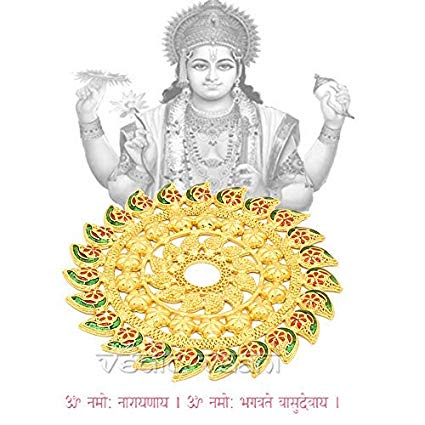
Sudarshan chakra - Due to the circular shape of Jambudvipa it is also called by the name Sudarshan
In the Skanda Purana, Jambudvipa is further described as the "shape of the solar disc" (Skanda 1.2.37:16). Whilst most of us have been led to believe that all the planets including the sun are globe-shaped, the Puranas actually describe the Earth, Sun, and Moon, as discs (mandalas). The Sun, for example, has the form of a one-wheeled chariot—it is not globe-shaped, but wheel-shaped.
"The chariot of the sun-god has only one wheel (ekam cakram), which is known as Samvatsara. (SB 5.21.13)
ekam—one; cakram—wheel
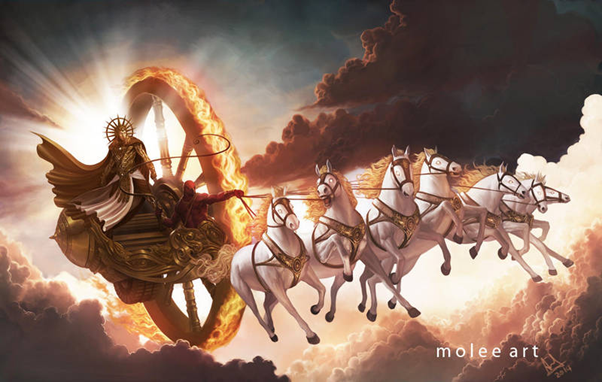
The Vedic Sun is disc-shaped like a wheel, not globe-shaped
In Srimad Bhagavatam, both the sun and moon are referred to as mandalas (see: surya-mandale SB 5.7.13; and candra-mandala-caruna SB 6.7.5). [Interestingly, the Nordic Trundholm Sun Chariot shows the sun as a disc pulled by a chariot].
These various references establish that Jambudvipa (as described by Sukadeva Goswami) is 'circular like a lotus leaf', not globular like a ball. With the understanding that a lotus leaf lies horizontal on the water, we can understand that the other islands and oceans that surround Jambudvipa in the form of concentric circles are all next to each other and thus on the same horizontal plane as Jambudvipa itself:
"The seven continents and the seven oceans encircle each other. They are in contiguity with each other, surrounding each other naturally". (Vayu Purana, chapter 42: 122)
Danavir Goswami's translation:
"Like this, the seven islands are surrounded by the seven oceans. First an island, next an ocean, again an island, again an ocean—this is the order." (Vayu Purana, 49:122 Danavir Goswami's edition)
The image below shows the seven islands and oceans of Bhu-mandala as one would expect a contiguous landscape to look:
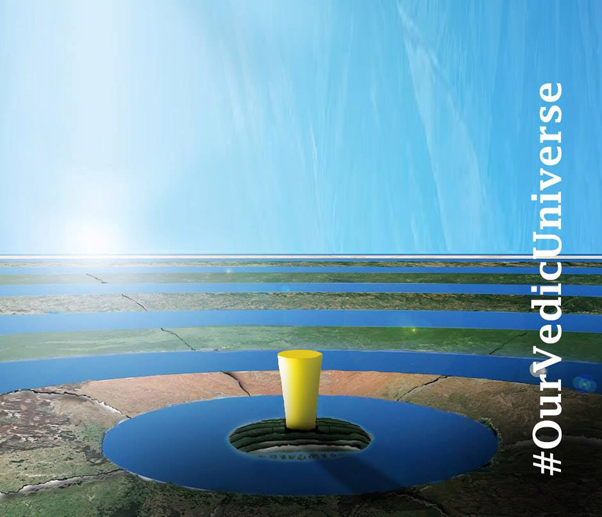
All of this wonderful landscape belonging to the great circle simply disappears in Danavir Goswami's conception of the Earth as an Earth globe in space. Although Danavir Goswami acknowledges the circular nature of Jambudvipa, he insists that part of this circular plane manifests as a globe, and that's where the initial mistake in Danvir Goswami's 'Vedic Universe' begins:
Danavir Goswami: "We don't find a description in the sastras of Jambudvipa as being spherical—circular yes, spherical no. Regarding the earth we live on which is called Bharata-khaṇḍa, it appears that it is a completely round sphere."
We should note here that in his reply, Danavir Goswami does nothing to build context by informing the inquirer of what is meant by Jambudvipa. The inquirer is told that Jambudvipa as circular, but not that it is a 800,000 mile circular island containing mountains, rivers, trees, people, animals, etc. Since Sukadeva Goswami's description reveals that our small area of the Earth is just a small part of this larger Earth landscape, is it not a relevant point to inform the inquirer of the context in which Bharata-varsha is located? By context I mean explaining the physical and personal nature of the world that is described to be surrounding our own. Jambudvipa, after all, is a real place with people and civilizations. If one wishes to say that our part of Jambudvipa manifests as an isolated globe floating in space, then the question is what becomes of the rest of the landscape to which we belong. In Danavir Gowami's 'Vedic Cosmos', all the residents of Jambudvipa suddenly just 'impersonalize', the rest of Bhu-mandala vanishes, and, lo and behold, we are back on the ball floating in dark lonely space. The following image of 'the' Earth is from Danavir Goswami's 'Vedic Cosmos' documentary:
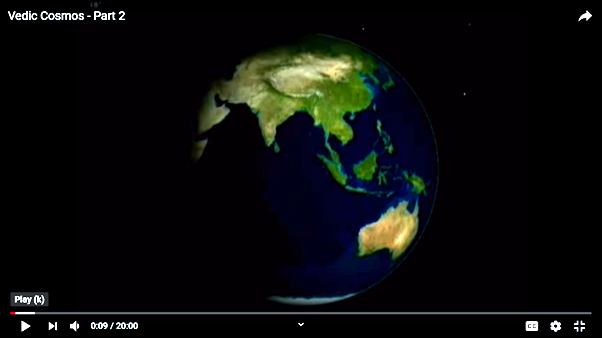
The animation presented by the Temple of Vedic Planetarium likewise 'impersonalizes' the entire landscape of Bhu-mandala which is represented as space between circles:
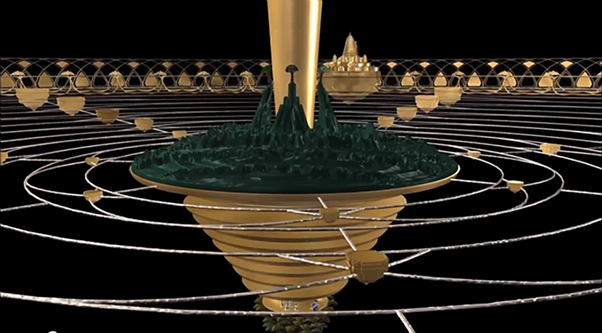
Sukadeva Goswami has words to describe the islands, mountains, rivers, trees, animals, and people of Bhu-mandala because such varieties of existence occupy a place on the Earth's huge physical landscape—they are not to be thought of as voids in circles of space.
Since the Vedic and modern concepts of the Earth are completely opposed, both Danavir Goswami's and the TOVP's presentation of the Earth as globe floating in space will be at the cost of losing Srimad Bhagavatam's teaching that our known Earth is surrounded by vast areas of a much greater Earth landscape. As we have read already from Garga Samhita, Krishna states that there is only one Earth. Unfortunately, in the International Society for Krishna Consciousness, Krishna's devotees have been led to believe that they live on an Earth globe rather than on the plane of Bhu-mandala. We have pointed out the fallacies in this conception over the course of 20 some thing articles, yet devotees of the stature of Danavir Goswami keep repeating the same misleading arguments.
DID SRILA PRABHUPADA BELIEVE THAT THE EARTH IS A GLOBE? UNDERSTANDING SRILA PRABHUPADA'S STATEMENTS ABOUT THE EARTH IN CONTEXT
We opened this paper with a statement from Danavir Goswami claiming that the names for Bhu-mandala were references to the supposed Earth globe. The whole idea that the Vedas reveal an Earth globe is simply a phantasmagoria made-up from such fallacious arguments. Though we are not hopeful of the present leadership of ISKCON challenging the current Earth paradigm, we point out these misleading arguments for the sake of those alert devotees who can still discern correct from incorrect, and who value truth above 'the party line'. We beg to question why one in the position of leader and teacher and supposedly seeing through the eyes of shastra, is falsely equating names of Bhu-mandala with the supposed Earth globe. Danavir Goswami may argue that in this regard he is simply following Srila Prabhupada's translations and purports to Srimad Bhagavatam wherein he refers to Bhu-mandala as the Earth globe, but such a procedure conveniently ignores Srila Prabhupada's own disclaimer that since he was not an expert in Vedic cosmology and astronomy, then his disciples need to diligently 'understand the Sanskrit descriptions and present them'. The following are of a few of the many statements Srila Prabhupada made in this regard:
The subject matters of physics, chemistry, mathematics, astronomy, time and space dealt with in the above verses of Srimad Bhagavatam are certainly very interesting to students of the particular subject, but as far as we are concerned, we cannot explain them very thoroughly in terms of technical knowledge. (SB 3.11.14)
We have Srila Prabhupada's own words regarding his translation of the cosmology section of the fifth canto:
Prabhupada: And it was not possible for me to digest. (laughs) Somebody else helped me to... I am a layman. I do not know.
Tamala Krishna: How did you write it?
Prabhupada: That somebody, Krishna, helped me. That He manufactured... When I was writing, I was praying Krishna that "I do not actually accommodate all this knowledge. Please help me." (Room Conversation, June 18, 1977, Vrindavana)
Srila Prabhupada again mentioned to a Vedic astronomer regarding the fifth canto cosmology:
Prabhupada: I have tried to translate it as far as possible, but I am not satisfied. (Conversation with India Astronomer, April 30, 1977, Bombay)
We also have Srila Prabhupada's statement to Paramahamsa dasa during a discussion about the fifth canto's cosmology. The following extract is from The Great Transcendental Adventure by Kurma dasa:
"Later in his room, Srila Prabhupada discussed more about Vedic cosmology with Paramahamsa. The different planetary orbits, Srila Prabhupada said, were all independent; the so-called law of gravity was not mentioned as such in the Vedic literature. Prabhupada answered a few more of Paramahamsa's questions about the current work on Srimad Bhagavatam, Fifth Canto, and then fell silent. "Actually," he added, after a few minutes, "I am not giving any more information -- simply what is there." Prabhupada was frank. "I am not an astronomer, so I may not understand all the details. Those details are given in another part of the Vedas. Sukadeva Gosvami is giving some basic summary ideas of the universal operation. The stress," Prabhupada concluded, "is on devotion, not geography." (The Great Transcendental Adventure, Ten Days in Perth, 1975, by Kurma das)
Again, this is an important statement from Srila Prabhupada in regards to his acquaintance with the details of the fifth canto cosmology: "I am not an astronomer, so I may not understand all the details."
Although Srila Prabhupada was the initiator of the great project to present the Vedic cosmology at the Mayapur Temple of Vedic Planetarium, as we can see from the above statements he did not present himself as an authority on the subject. For that reason, Srila Prabhupada instructed his own disciples that they should diligently 'understand the Sanskrit descriptions and present them'. Simply quoting Srila Prabhupada's translation of Bhu-mandala as 'Earth-globe' without understanding the difference between the two concepts does not serve Srila Prabhupada's desire for his disciples to exactly follow the description of Srimad Bhagavatam, nor lessen his transcendental anxiety to ensure there will be no cause to find fault in the presentation:
"We must exactly follow the description of Bhagavatam. As we are going to spend many crores of rupees, and there will be those who will try to find fault in our presentation, 'Caesar's wife must be above suspicion.' I have explained whatever I could already in my books. Now my brain is no longer able to work properly. You young men can tax your brains to understand the Sanskrit and English descriptions and present them." (TKG's Diary: Prabhupada's Final Days, May 30 1977)
"Now our Ph.D.'s must collaborate and study the Fifth Canto to make a model for building the Vedic Planetarium... So now all you Ph.D.'s must carefully study the details of the Fifth Canto and make a working model of the universe. If we can explain the passing seasons, eclipses, phases of the moon, passing of day and night, etc., then it will be very powerful propaganda." (Letter from Srila Prabhupada to Svarupa Damodara dasa, April 27, 1976)
How can anyone who has claimed to study the details of the fifth canto possibly argue that references to Bhu-mandala are references to an Earth globe? Bhu-mandala is 4 billion miles in diameter! Read the description! Though pertaining to follow Srila Prabhupada's Bhagavatam translation and purports, the above presentation by Danavir Goswami consistently ignores Srila Prabhupada's later instructions to sort out the difference between the Vedic and modern conceptions of the Earth. For example, in the following conversation, Tamala Krishna Goswami shows his clear comprehension that Srimad Bhagavatam does not describe the Earth as a round globe. Srila Prabhupada deftly responds by instructing Tamala Krishna Goswami to find out the answer according to Srimad Bhagavatam:
Tamala Krishna: Look at the Earth. Now, this is a real question that we still have to answer. They picture the Earth round, and we say, no. Bhu-mandala is like a lotus, like this, and the Earth is only one part of one island in Bhu-mandala, and it's not, you know, it's not round(?). It doesn't look like that. And all the pictures they take of the earth when they go up in their satellites show round. And we're going to tell them that it's not. This is a very tricky question...
Prabhupada: So are you thinking on this?...Find out from our side, according to Bhagavatam. (Bhu-mandala Diagram Discussion, July 2 1977, Vrindavana)
To all members of ISKCON who are fixated on the idea that Srila Prabhupada taught conclusively that the Earth is a globe, let's consider Srila Prabhupada's response to Tamala Krishna Goswami's analysis that the Vedic Earth is 'not round', that 'Earth is only one part of one island in Bhu-mandala'. This is one of Srila Prabhupada's final discussions on the subject and is of great importance. Now does Srila Prabhupada say in response to Tamla-Krishna: "You offender, you apostate, how dare you question the acharya. In my translations, purports, conversations and lectures I said the Earth was a round planet floating in space, so how dare you doubt or contradict me". Does Srila Prabhupada say like that? Well? What does he say? He pertinently asks Tamala Krishna Goswami: "ARE YOU THINKING ON THIS? " Now what does Srila Prabhupada mean by that? Obviously, Srila Prabhupada is saying to Tamala Krishna Goswami to use his intelligence to figure out the disparity between the two world views. And how is the disparity to be explained? Srila Prabhupada says: "FIND OUT FROM OUR SIDE ACCORDING TO BHAGAVATAM" Does Srila Prabhupada say, "I've already given my verdict in Srimad Bhagavatam: the Earth is a round globe floating in space". No he doesn't say that. He tells his disciple that he should study the text to "FIND OUT" what the Srimad Bhagavatam actually says.
This instruction is consistent with half a dozen other instructions for other disciples to do the same thing. In the links below, and scattered through various papers, we have presented a history and explanation of why Srila Prabhupada referred to the Earth as a globe, despite Srimad Bhagavatam describing it differently. If anyone thinks otherwise, we request to please take the evidence presented in the links below, and then present the counter evidence. See here and here.
Srila Prabhupada is not simply being humble here when he states that cosmology, astronomy, etc., are not his field. He is making such statements because there is an important task at hand, and he is asking for practical assistance. In the above statements, Srila Prabhupada emphasizes that he wants the Vedic cosmology to be presented in the Temple of Vedic Planetarium as it is, and he is requesting his disciples to assist him in deciphering and presenting the thing as it is described. Although Srila Prabhupada had full faith in the descriptions of the Vedic universe as they are revealed by Sukadeva Goswami (see, for example, the purports to SB 5.16.10 and SB 2.7.13), the difficulty was that for most of his translation of Srimad Bhagavatam, and through-out his years of preaching, Srila Prabhupada didn't have a single map or any type of work that addressed the differences between the Vedic and modern conceptions of the Earth. Srila Prabhupada was single-handedly attempting to revive Vedic cosmology in the modern world, but practically all knowledge of the subject had been covered over in course of time, and basically no-one had an idea of how to depict the Vedic cosmos in a three dimensional form. As one astronomer replied to Srila Prabhupada's request:
Prabhupada: Immediately we want the diagram how to fix it up so that people can see, "This is the situation." So you make this diagram.
Indian Astronomer: It is first attempt to give in picture the ideas of Bhagavatam. (Conversation with India Astronomer, April 30, 1977, Bombay)
Having no precedent to work from, Srila Prabhupada, for the most part, referred to the Earth in the conventional sense, and as a convenience had simply conflated the Vedic and modern conceptions of the Earth. An example illustrating how Srila Prabhupada would sometimes pragmatically use conventional ideas can be seen in the following conversation wherein Srila Prabhupada says 'sometimes I have said or taken this modern theory'.
Tamala Krishna: Prabhupada, there's another question I have. I remember on a walk...I have read in your books that the moon's glowing is due to reflecting the sun. Then I remember on a walk in Vrindavana you said that the moon is fiery just like the sun, but there's a cooling atmosphere around it. So is it actually fiery glow, or is it simply a reflecting glow?
Prabhupada: That is stated in Bhagavatam.
Gurudasa: It says reflection in the Bhagavata.
Prabhupada: No, it is also a fiery place. But it is because it is far away from the sun, it is not so glowing.
Tamala Krishna: So it's not a question of reflection only.
Prabhupada: The reflection theory is the modern theory.
Tamala Krishna: Because sometimes in the books it's stated...
Prabhupada: Yes. Sometimes I have said or taken this modern theory.
Tamala Krishna: Just so that people will understand an example. I see.
(Morning Walk Conversation, March 18, 1976, Mayapur)
Throughout Srila Prabhupada's conversations and lectures he insisted many times that the moon shines by its own light, and is not a reflection of sunlight which is the 'modern theory'. In the above conversation Srila Prabhupada makes the point that although the Puranas describe the moon as having its own source of light; he has sometimes spoken of moon-light as a reflection of sunlight: 'I have sometimes said or taken this modern theory'. In Bhagavad-gita As It Is, for example, Srila Prabhupada writes:
"The sun is one, and as by the reflection of the sun the moon illuminates, so also do the stars". (Bg 10.21 purport)
In the above example, Srila Prabhupada simply works with the common understanding of how moon-light is understood as a reflection of sunlight. The actual fact is that the moon has its own source of light and is not a reflection of sunlight. Therefore, one has to study the different occasions and circumstances (context), in which Srila Prabhupada spoke, and thereby discern when Srila Prabhupada is making arguments to establish tattva (the truth of something), or simply using common everyday language and examples in the course of a discussion. This is particularly important when it comes to understanding Srila Prabhupada's statements about the Earth. For example, in the two statements that shall follow, Srila Prabhupada compares the Earth to the shape of a ball. By looking at the overall context of the lecture and discussion, we can easily understand and appreciate that Srila Prabhupada refers to the common understanding of the shape of the Earth as a mere example to illustrate an entirely different preaching point, and that he is not attempting to establish the tattva in regards to the Earth. However by simply disregarding the context in which they are spoken, and by failing to understand such statements in relation to the description of the Earth given in Srimad Bhagavatam, the following statements are foolishly seized upon by some of Srila Prabhupada's disciples and followers as 'evidence' from Srila Prabhupada that the Earth is globe-shaped. For example:
Just like here, in this planet, when you go up, you see it is ball (lecture on Bhagavad-gita 2.12, March 9, 1966)
If we look at the context within the lecture, the statement has nothing to do with a discussion about establishing the shape and size of the Earth according to Srimad Bhagavatam. Srila Prabhupada is just using a common understanding of the Earth to illustrate an entirely different preaching point. Again:
"How much big the Varaha animal was to show that it can pick up the whole earth, earthly planet just like a ball. He cannot imagine such big animals." (Philosophical discussions with Shyamasundara dasa on Charles Darwin)
Again the discussion has absolutely nothing to do with determining the shape and size of the Vedic Earth, and is an example of using the Earth globe idea to illustrate an entirely different preaching point. Lord Varaha actually lifted the entire Bhu-mandala as we have established in the paper, "Did Lord Varaha Lift an Earth Globe?".
In the above paper we have presented a discussion between Srila Prabhupada and his disciples on the topic of Lord Varaha lifting the Earth. During this discussion Srila Prabhupada affirms Bhakti-prema dasa's evidence that Varaha lifted the entire Bhu-mandala, not an Earth globe. Why then do members of ISKCON continue to mislead others devotees by presenting the above two statements from Srila Prabhupada (comparing the Earth to the shape of a ball) as proof that Prabhupada believed the Earth was a globe. Srila Prabhupada obviously believed the Earth must be as it is described in Srimad Bhagavatam. The problem was that Srila Prabhupada didn't have any map, image, or explanation that showed what the whole Vedic Earth looked like, and therefore simply spoke of the Earth using the common language and understanding.
In neither of the above examples is Srila Prabhupada attempting to establish the tattva or truth about the Earth's shape and size, and yet the statements are presented as if they do establish the tattva of the Earth. We can understand that many devotees have not studied the details of the Vedic Earth, and may innocently repeat such statements made by Srila Prabhupada in regards to the Earth being a globe. However, via our papers on Sampradaya Sun we have certainly explained the matter in detail to those supposedly researching and writing on the subject of Vedic cosmology. We therefore wonder what motivates such members of ISKCON to continue misleading others in regards to Srila Prabhupada's statements when the facts and truth of the matter have been made abundantly clear.
In ISKCON, devotees take these references to 'the Earth globe' and 'Earth planet' as the last word on the issue, despite Srila Prabhupada's own disclaimer that he was not an expert in the details of the subject. Srila Prabhupada had unshakable faith in the Srimad Bhagavatam's description of the Vedic cosmos, but how it all looked and worked was another matter. Thus Srila Prabhupada would speak, for example, of bila-svarga as 'subterranean heavenly planets' giving the impression that they are planets floating in space, when they are actually seven realms within the vast depths of the Bhu-mandala's core. See, our previous paper called "What's Below the Earth?".
Again, Srila Prabhupada referred to Amaravati, for example, as 'the capital city of the heavenly planets'. Although we think of a 'heavenly planet' as floating somewhere out in space, Amaravati is actually located on the top of Mount Meru, and Mount Meru is in the center of the Earth-circle, specifically in Jambudvipa, the first of the Earth's seven great comic-sized islands). There is no fault on Srila Prabhupada's part as he did not have a map of Bhu-mandala which would explain the relative location of each place within the Vedic universe, but followers of Srimad Bhagavatam should be conscious that many places described by Srila Prabhupada as 'planets' are actually just parts of the colossal Vedic Earth circle. The important point we take from Srila Prabhupada here is his revolutionary teaching that conscious life and civilizations are spread through-out the universe. The actual whereabouts of each place is another matter to consider, and this is precisely what Srila Prabhupada wanted his disciples to discover. Srila Prabhupada personally delegated the task of creating a map of the universe to his disciples. A very rudimentary map of Bhu-mandala was eventually prepared for Srila Prabhupada by June 1977, and despite some discussion on the differences between the Vedic and modern models of the Earth took place, the issue was unfortunately unresolved by the time of Srila Prabhupada's departure only a few months later in November 1977.
Although Srila Prabhupada is not at fault in his presentation of the Earth as a globe, the same cannot be said of those disciples who are presenting Prabhupada's statements out of context, and making various convoluted arguments in order to claim that both shastra and parampara describe Bharata-khanda as globe. Followers of Srila Prabhupada need to appreciate that despite speaking of the Earth with the conventional understanding that Earth is a globe floating in space, the bottom line is that Srila Prabhupada ultimately believed the Earth must be as Srimad Bhagavatam describes it. Therefore, Srila Prabhupada insisted time and again that his disciples present the Srimad Bhagavatam's version in the TOVP. Srila Prabhupada's disciples are doing him a great disservice when they fail to understand and present Bhu-mandala as it is, but simply cling to the mantra that "Srila Prabhupada called the Earth a globe, therefore it must be a globe".
The failure to understand Srila Prabhupada's mind on this issue is perhaps the result of a misplaced sentiment. For example, Harikesha dasa (aka Harikesha Swami) quotes Srila Prabhupada as follows:
"As Srila Prabhupada once said, "Right or wrong, my Guru Maharaja was always right." (Our Original Position, chapter 13 A letter by Harikesha Swami)
The message is often repeated in lectures, Vyasa Puja offerings etc:
"Right or wrong, you're always right. Please save me from this fearful plight.
The task of saving the wild, wild West. Verily required Lord Krishna's very best".
However, the idea here is not to unthinkingly repeat information without consideration of whether it is right or wrong; the idea is not to ascribe a wrong motive to a Krishna's pure devotee should any such mistake occur. For example in his preaching to expose the American moon landing hoax, Srila Prabhupada would often state that the moon is 1,600,000 miles above the sun. However, the moon is actually 1,600,000 miles above the Earth itself, not the sun. The sun is 800,000 miles above the Earth and the moon is 800,000 miles above the sun. In either case, the moon is 1,600,000 miles away and that is really the point that Srila Prabhupada wishes to make. Saying that the moon is 1,600,000 above the sun is a simple mistake that does not make a difference to the essential point that Srila Prabhupada was trying to stress; namely, that American astronauts could not have went to the moon in three or four days because according to shastra, the moon is 1,600,000 miles away, not 225,623 miles away as claimed in modern cosmology. We certainly agree and accept Srila Prabhupada's various arguments as to why the moon landing was a hoax. The important point to take here from Srila Prabhupada's example is how to apply shastra to analyse the false claims of the modern asuras. The fact that Srila Prabhupada made a trivial 'mistake' in calculation is irrelevant to the more important preaching point that is being made here. Nonetheless, for the purpose of creating a working model of the universe for the Temple of Vedic Planetarium, the correct calculation of the distance between sun and moon has to be accurately presented according to the shastra:
"The sun's disc is situated one lakh [100,000] yojanas[800,000 miles] above the Earth, and 100,000 yojanas[800,000 miles]
above it, is the moon's disc." (Vishnu Purana 2.7.4)
Srila Prabhupada confirms in his own Srimad Bhagavatam translation:
"Above the rays of the sunshine by a distance of 100,000 yojanas[800,000 miles] is the moon" (SB 5.22.8)
This makes the moon 1,600,000 miles above the Earth, not above the sun If one were to think that 'right or wrong, you are always right' and not present the correct calculation, Srila Prabhupada would not be pleased that the shastra is not accurately presented as specific calculations have important implications for the overall working of the model.
The same criteria for understanding Srila Prabhupada's statements about distances between the sun and moon, also applies in understanding Srila Prabhupada's statements about the Earth itself; and especially when it comes presenting the Vedic Earth at the Temple of Vedic Planetarium. Despite Srila Prabhupada referring to the Earth as a globe, if the shastra reveals the Earth to be something different, then the version of Srimad Bhagavatam has to be presented. Srila Prabhupada himself authorized such an approach in his response to Tamala Krishna Goswami's analysis that the our Earth is 'not round', that, 'Earth is only one part of one island in Bhu-mandala'. In his response, Srila Prabhupada authorized Tamala Krishna Goswami to investigate the discrepancy: "Are you thinking on this? Find out from our side, according to Bhagavatam".
Members of ISKCON have to understand that during the period of Srila Prabhupada's preaching, an understanding of the differences between the Vedic and modern conceptions of the Earth was in the early stages; we can thus appreciate that there is no fault on Srila Prabhupada's part for simply speaking of the Earth in the conventional sense of it being a globe in space. One should not infer from our presentation here that Srila Prabhupada was presenting wrong information about the Earth, or that his stature as an acharya is diminished for having spoken of the Earth differently from how it is described in Srimad Bhagavatam. In the absence of a clear conception of Bhu-mandala, what other language could Srila Prabhupada have used? It was the language of the day. Srila Prabhupada's unfamiliarity with the nature and lay-out of Bhu-mandala was due to the fact that all knowledge of Bhu-mandala had been covered over and practically forgotten before his own transcendental inspiration to revive Vedic cosmology in the modern world. In the light of this powerful preaching endeavour, it is hardly a fault on Srila Prabhupada's part that he spoke of the Earth in the conventional sense as a planet floating in space. Despite Srila Prabhupada's unfamiliarity with all the details of Bhu-mandala, the true nature of the Earth's shape and size will eventually come to light only because of Srila Prabhupada's own catalytic inspiration to revive Vedic cosmology in the modern world. Thus although using the language of the current Earth paradigm, Srila Prabhupada's Temple of Vedic Planetarium will ultimately change our whole understanding of the true size and shape of the Earth. Srila Prabhupada explains the point of motive in the following purport:
"A devotee should be fixed in the conclusion that the spiritual master cannot be subject to criticism and should never be considered equal to a common man. Even if there appears to be some discrepancy according to an imperfect devotee's estimation, the devotee should be fixed in the conviction that even if his spiritual master goes to a liquor shop, he is not a drunkard; rather, he must have some purpose in going there". (Caitanya-caritamrta, Antya-lila 3.1 purport)
[NB: The idea here is not to ascribe an ulterior motive to a pure devotee of Sri-Krishna; it is not intended to blind one to the motives of someone pretending to be a pure devotee of Sri-Krishna. The wrong application of this idea has created havoc in the guru-disciple relationship in ISKCON, with many devotees blindly following a guru despite their blatant deviation from spiritual practice].
The point we wish to make is that Srila Prabhupada did not have an ulterior motive in presenting the Vedic Earth as globe-shaped—he simply didn't know what the actual Vedic Earth looked like. He was, in fact, seemingly in anxiety that the Bhu-mandala and other aspects of Vedic cosmology be depicted 'exactly' according to Srimad Bhagavatam. Srila Prabhupada's one and only desire in unveiling Srimad Bhagavatam's cosmological descriptions at the Temple of Vedic Planetarium was to counteract the false claims of the modern asuras in regards to understanding the nature of life and the universe.
Whilst the idea of 'right or wrong you are always right' is a perfect sentiment for a humble disciple of Srila Prabhupada to take, in this instance, simply presenting Srila Prabhupada's references to the Earth being a round globe floating in space (as a proof that it is so), does not serve Srila Prabhupada's desire to correctly represent the Vedic cosmology at the Temple of Vedic Planetarium. It is like giving Srila Prabhupada milk when he asked for water. Milk is tasty and nutritious certainly, but if guru asks for water it is because the body requires water—and milk does not serve the purpose which only water can do. Srila Prabhupada made a specific request for his disciples to study the fifth canto of Srimad Bhagavatam and make a working model of the universe. In regards to the nature of the Earth in the Vedic universe, a disciple may think he is pleasing guru by presenting statements wherein Srila Prabhupada refers to the Earth as a globe. In doing so the disciple may think he is being loyal and faithful to Srila Prabhupada and parampara. However, in this instance, the sentiment that "if Srila Prabhupada called the Earth a globe then it must be a globe", or 'right or wrong, Srila Prabhupada is always right' is simply a lazy response, and does not take into account the various factors of why Srila Prabhupada spoke of the Earth in that manner, and why he personally requested a study into the difference between the Vedic and modern ideas. Such a disciple will forever remain in a state of cognitive dissonance regarding the nature of the Earth because quite simply, the description of Bhu-mandala is not a description of an Earth globe. Such a disciple may never come to understand or appreciate the great disclosure of Earth's true nature, and will simply remain mentally locked within an illusory concept of the Earth.
I cannot over-emphasize enough that a review of Srila Prabhupada's statements on the Earth applies only in this specific area, and is not a carte blanche to question Srila Prabhupada's authority as an acharya and pure devotee of Sri Krishna, nor even to throw doubt on Srila Prabhupada's statements in regards to other aspects of Vedic cosmology. For example, on the basis of the fifth canto's description of the distance between the Earth and the moon, (as well as other factors), Srila Prabhupada was probably the first person to expose the American moon-landing as a hoax. We hope at some point to have the time to write a paper on Srila Prabhupada and the Moon-landing Hoax as it is another area where several devotees have added their own speculations and assumptions and have almost covered Srila Prabhupada's consistent stance that the whole thing was a 'colossal hoax' filmed here on the Earth. But that is a topic for another day. I only wish to point out here that Srila Prabhupada taught us how to question the claims of the modern asuras by analyzing them in the light of shastra. Just as Srila Prabhupada used shastra as a basis to expose the moon-landing as a hoax, so we can likewise use shastra to question and expose the science and images that purport to show Earth as a globe floating in space.
Questions arise specifically in regards to the shape and size of the Earth, firstly because there is an obvious and massive difference between the Vedic and modern conception of the Earth; secondly because the matter was raised with Srila Prabhupada, but without a resolution; thirdly because Srila Prabhupada specifically requested his disciples to study the fifth canto in order to come up with a working model of the Vedic universe. We are merely pointing out that there is no description in the shastra of a globe-shaped Earth planet floating in space; on the contrary, the shastra clearly describes our area of Bharata-varsha to be part of a greater Earth landscape.
Having established above that Jambudvipa and the other islands of Bhu-mandala are part of a circular horizontal (flat-Earth) plane, surely the actual focus in ISKCON's Vedic cosmology should be on this essential point of Srimad Bhagavatam's teaching, namely, that we are part of a stupendous Earth circle with more land, people, and civilizations all around us. The only question is whether part of this great Earth plane (in the area of Bharata-varsha) actually manifests as a globe. The idea is never mentioned in any of the original Puranas. Srila Prabhupada himself never attempted to make an argument for this idea, nor do any of the other acharyas in their commentaries on the fifth canto ever suggest that Bharata-khanda manifests as a globe in space. This idea is purely the invention of some of Srila Prabhupada's disciples who are obviously conditioned by the modern belief that the Earth must be as it is seen in NASA's iconic images of a so-called Earth from so-called space.
Part of Danavir Goswami's 'evidence' for the idea that Bharata-khanda manifests as an Earth globe is a reference to Srila Bhaktisiddhanta Sarasvati Thakura's edition of Siddhanta-siromani wherein he cites four sources that give measurements for a smaller Earth. In part three of this paper we shall argue that Danavir Goswami has completely misrepresented Srila Bhaktisiddhanta Sarasvati Thakura's position on the question of the Earth's shape and size, as well as completely misunderstood what the smaller measurements are referring to.